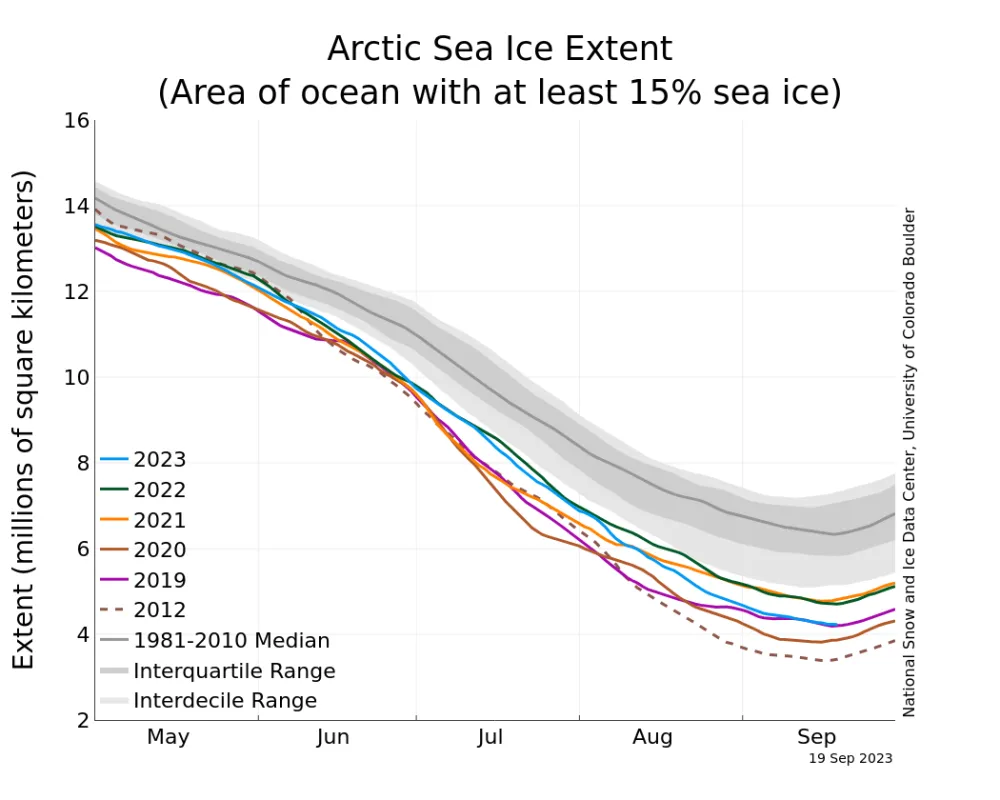On September 19, Arctic sea ice likely reached its annual minimum extent of 4.23 million square kilometers (1.63 million square miles). The 2023 minimum is sixth lowest in the nearly 45-year satellite record. The last 17 years, from 2007 to 2023, are the lowest 17 sea ice extents in the satellite record.
In the Antarctic, sea ice extent set unprecedented record lows through most of the growth season. Highly variable conditions are typical of Antarctic sea ice extent near the seasonal maximum, and ice may still continue to grow but will unlikely avoid setting a record low. The previous five lowest maximums on record include 1986, 2002, 2017, 1989, and 2022. The maximum for Antarctic sea ice typically occurs in late September or early October, but has been as early as August 30.
Please note that this is a preliminary announcement. Changing winds or late-season melt could still reduce the Arctic ice extent, as happened in 2005 and 2010. NSIDC scientists will release a full analysis of the Arctic melt season, and discuss the Antarctic winter sea ice growth, in early October.
Overview of conditions
On September 19, sea ice reached its annual minimum extent of 4.23 million square kilometers (1.63 million square miles) (Figure 1). As the sun continues to lower on the horizon, air temperatures will drop further, expanding ice extent through autumn and winter. However, with significant patches of low ice concentration a late season storm may compress the sea ice and push the ice extent lower.
The minimum extent was reached five days later than the 1981 to 2010 median minimum date of September 14. The interquartile range of minimum dates is September 11 to September 19.
Conditions in context
This year’s minimum set on September 19 was 840,000 square kilometers (324,000 square miles) above the satellite-era record minimum extent of 3.39 million square kilometers (1.31 million square miles), which occurred on September 17, 2012 (Figure 2). It is also 1.99 million square kilometers (770,000 square miles) below the 1981 to 2010 average minimum extent, which is equivalent to nearly three times the size of Texas.
In the 45-year-satellite record, 17 of the lowest minimums have all occurred in the last 17 years.
The overall, downward trend in the minimum extent from 1979 to 2023 is 12.5 percent per decade relative to the 1981 to 2010 average. The loss of sea ice is about 77,800 square kilometers (30,000 square miles) per year, equivalent to losing the state of Nebraska or the Czech Republic annually.
Seventeen lowest minimum Arctic sea ice extents (satellite record, 1979 to present)
| RANK | YEAR | MINIMUM ICE EXTENT | DATE | |
|---|---|---|---|---|
| IN MILLIONS OF SQUARE KILOMETERS | IN MILLIONS OF SQUARE MILES | |||
| 1 | 2012 | 3.39 | 1.31 | Sept. 17 |
| 2 | 2020 | 3.82 | 1.47 | Sept. 16 |
| 3 | 2007 2016 2019 | 4.16 4.17 4.19 | 1.61 1.61 1.62 | Sept. 18 Sept. 10 Sept. 18 |
| 6 | 2023 | 4.23 | 1.63 | Sept. 19 |
| 7 | 2011 | 4.34 | 1.68 | Sept. 11 |
| 8 | 2015 | 4.43 | 1.71 | Sept. 9 |
| 9 | 2008 2010 | 4.59 4.62 | 1.77 1.78 | Sept. 19 Sept. 21 |
| 11 | 2018 2017 2022 | 4.66 4.67 4.70 | 1.80 1.80 1.81 | Sept. 23 Sept. 13 Sept. 19 |
| 14 | 2021 | 4.77 | 1.84 | Sept. 16 |
| 15 | 2014 2013 | 5.03 5.05 | 1.94 1.95 | Sept. 17 Sept. 13 |
| 17 | 2009 | 5.12 | 1.98 | Sept. 13 |
Values within 40,000 square kilometers (15,000 square miles) are considered tied. The 2022 value has changed from 4.67 to 4.70 million square kilometers (1.81 million square miles) and the date of the minimum moved from September 18 to September 19 when final analysis data updated near-real-time data.
For more information
NASA visualization of 2023 Arctic sea ice minimum extent

